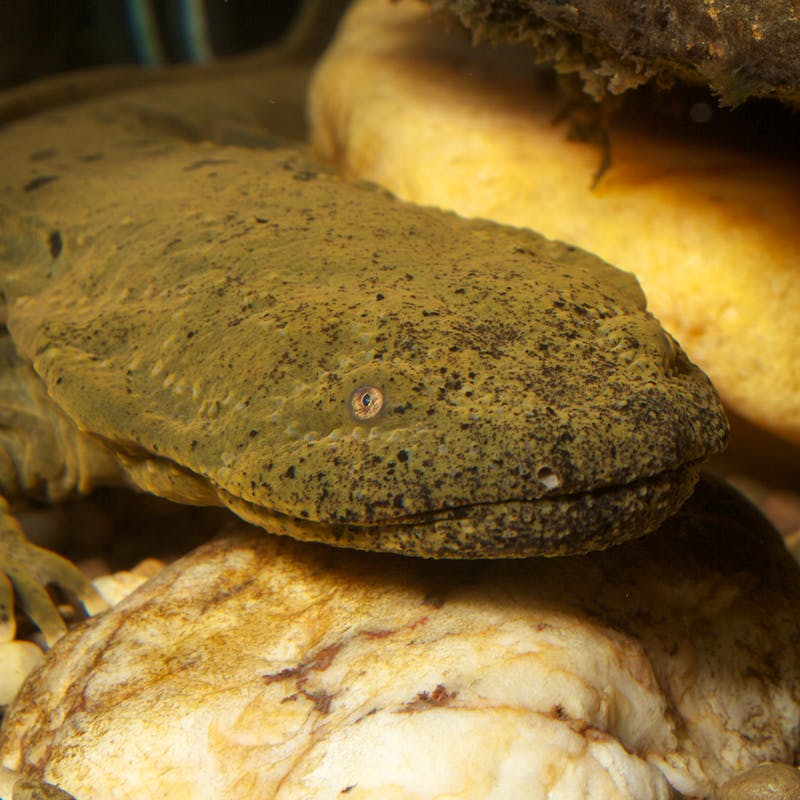A Summer-long Search for North America’s Largest Salamander
Deep in rural western North Carolina, a team of conservationists readied their gear and prepared to wade into a stream. Some were armed with clipboards and waders, while others wore neoprene and snorkeling masks. We were thrilled to join these conservationists and happy to spend a few hours in the cold mountain water with them, searching for the elusive eastern hellbender.
Over the past ten weeks, Defenders of Wildlife staff and interns joined Ben Dalton, a Wildlife Diversity Technician and Lori Williams, a Wildlife Diversity Biologist, from the NC Wildlife Resource Commission (NCWRC) to survey for hellbenders in streams around the French Broad drainage in western North Carolina. Every summer teams like ours head out into hellbender habitat to study individuals and try to determine where populations are growing and declining.
The survey sites this summer ranged from twenty-meter-wide rivers with towering canopies, to three-meter streams through dense rhododendron tunnels. Regardless of the terrain, the process was uniform at every location. The survey team consisted of habitat data collectors and snorkelers. Usually, one to three volunteers were “habitat personnel” and started the survey by defining a thirty-meter stretch of the stream or river for the snorkelers to search. The snorkelers, donning wetsuits and neoprene from their fingertips to toes, spend hours in the water carefully inspecting the contours of the riverbed for any crevice that might contain the majestic “snot otter.”
We looked for adults—which were often found as a stoic face watching you from under a rock—and larvae, tiny versions of their enormous adult forms. Hellbenders are the largest salamander in North America with adults reaching up to 29 inches long. Larvae are about the same size as an average salamander, around 4 to 6 inches.
While the snorkelers looked for hellbenders, the habitat personnel collected environmental data, stream measurements and water chemistry data. Ben, who has been taking the hellbender research to the next level, compiled the data and developed a digital picture of each survey site after the survey was completed.
Surveys are just one way biologists determine the presence of hellbenders. Environmental DNA, or eDNA, is another method that has helped identify a lot of new streams as hellbender habitat. eDNA, however, doesn’t tell the whole story. Biologists won’t know if there are territorial adults, a new breeding or a declining population of hellbenders in those streams. Lori notes that since these animals have such a long lifespan, it can often be difficult to determine the population status of a given stream. About seventy percent of the hellbender streams fall under an “unknown” status, which makes it very difficult for biologists to gauge what’s happening with population in the state, provide protections for habitat and acquire funding for ongoing conservation and research.
Ben and Lori are the only two NCWRC biologists dedicated to studying and helping hellbenders in North Carolina. They were beyond grateful for the volunteer hours that Defenders provided, which allowed us to make over twenty survey passes at different sites during the short summer and will help leverage additional funding for this essential work to continue. We are equally grateful for the unique field experiences gleaned from working with such knowledgeable and dedicated biologists.
Consequently, Defenders has a standing invitation from Ben and Lori to recruit future “Hellbender Helpers.” Anyone interested should email southeastoffice@defenders.org. Public information regarding hellbender sightings is also enormously helpful. If you find a hellbender leave it alone but take a photo and note the location. Then, email lori.williams@ncwildlife.org with the information. If you’re fishing and catch one on a hook, carefully remove the hook if it’s safe to do so without hurting the animal or cut the line as close to the hook as possible and return the hellbender to the water. That way, you can be a Hellbender Helper, too!
This blog was written by our Southeast Field Conservation summer interns, Tory Ash and Michael Hampton.









Follow Defenders of Wildlife
facebook bluesky twitter instagram youtube tiktok threads linkedin